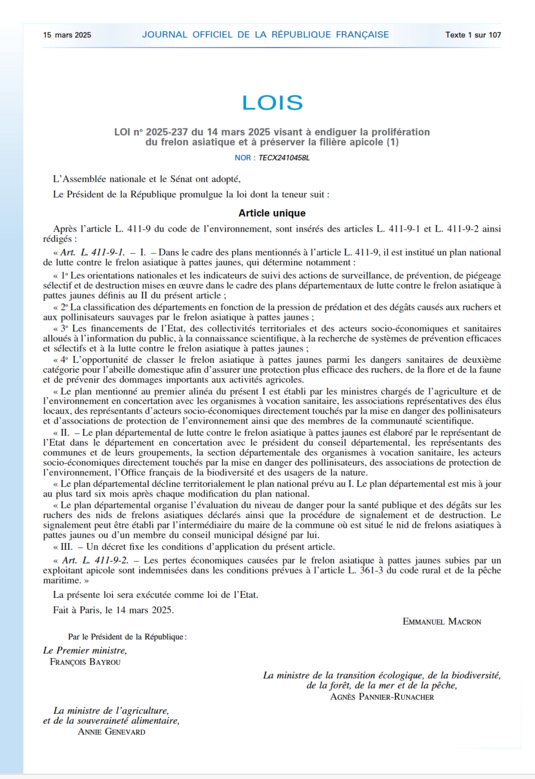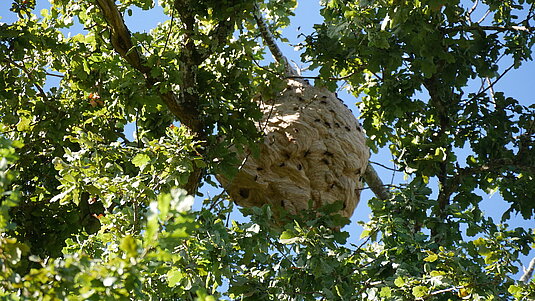Regulatory
LOI visant à endiguer la prolifération du frelon asiatique et à préserver la filière apicole Mars 2025
JO - LOI n° 2025-237 du 14 mars 2025 visant à endiguer la prolifération du frelon asiatique et à préserver la filière apicole (1) - Légifrance



Institution d'un plan national de lutte contre le frelon asiatique à pattes jaunes sous l'égide des ministres de l'Agriculture et de l'Environnement
BeesForLife a soutenu la démarche d’adoption de cette loi entre autres par une pétition Change.org et en communiquant avec les Sénateurs et Députés.
BeesForLife a développé depuis plus de 5 ans des outils de lutte contre le frelon asiatique permettant aux territoires (Département , communautés de communes, communes ) d’organiser la lutte sur le terrain.
La loi « visant à endiguer la prolifération du frelon asiatique et à préserver la filière apicole » à été votée à l’unanimité des Sénateurs et des Députés le 6 mars dernier.
Le représentant de l’Etat dans le Département est cité comme étant un des acteurs majeurs sur le terrain.
La loi du 6 mars prévoit d’organiser différentes actions pour lesquelles les moyens et les outils de BeesForLife répondent à la couverture des objectifs suivants exprimés dans cette loi.
PROPOSAL FOR A LAW ADOPTED BY THE SENATE on 11 APRIL 2024 to curb the proliferation of the Asian hornet and protect the beekeeping industry,
ASSEMBLÉE NATIONALE CONSTITUTION DU 4 OCTOBRE 1958 SEIZIÈME LÉGISLATURE Registered at the Presidency of the National Assembly on 11 April 2024.
PROPOSED LAW ADOPTED BY THE SENATE NO. 2473
to curb the proliferation of the Asian hornet
and preserve the beekeeping industry,
Sole article
I. - After article L. 411-9 of the Environment Code, the following are inserted
articles L. 411-9-1 to L. 411-9-3 as follows:
"Art. L. 411-9-1. - I. - As part of the plans mentioned in article
L. 411-9, a national plan to combat the Yellow-legged Asian
yellow-legged Asian hornet which determines in particular :
"1° National guidelines and monitoring indicators for surveillance, prevention
surveillance, prevention, selective trapping and destruction measures
implemented as part of the departmental plans for combating the Yellow-legged
plans defined in II of this article ;
"2° The classification of départements according to the pressure of
predation pressure and damage to apiaries and wild pollinators caused by the
the Yellow-legged Asian Hornet ;
"3° The funding allocated by the State, regional and local authorities
socio-economic and health players allocated to public information, scientific knowledge
scientific knowledge, research into effective and selective prevention
and selective prevention systems and for combating the Yellow-legged Asian Hornet;
"4° (deleted)
"5° (new) The advisability of classifying the Yellow-legged Asian
among the second category of health hazards for domestic bees in order to ensure greater
domestic bees in order to ensure more effective protection of apiaries, flora and fauna
flora and fauna and to prevent significant damage to agricultural
agricultural activities.
"The plan referred to in the first paragraph of this I is drawn up by the
the ministers for agriculture and the environment in consultation with
health organisations, representative associations of local elected representatives
representatives of socio-economic players directly affected by the threat to pollen
directly affected by the endangerment of pollinators and environmental protection
as well as members of the scientific community.
"II. - The departmental plan for combating the Yellow-legged Asian
the representative of the State in the département in consultation with the
the President of the Departmental Council, representatives of the local
municipalities and their groupings, the departmental section of health organisations
health organisations, socio-economic players directly affected by the endangerment of
directly affected by the endangerment of pollinators, environmental protection
associations, the French Biodiversity Office and nature users.
and nature users.
"The departmental plan sets out the national plan provided for in
in I. The departmental plan is updated no later than six months after each change in the
modification of the national plan.
"The departmental plan organises the assessment of the level of danger for
public health and damage to apiaries from declared Asian hornet nests, as well as the
and the procedure for reporting and destroying them. This
notification can be made via the mayor of the municipality in which the
the yellow-legged hornet nest is located or a member of the municipal
council member designated by him.
"III (new). - A decree shall lay down the conditions for application of this
article.
"Art. L. 411-9-2. - (Deleted)
"Art. L. 411-9-3. - Economic losses caused by the Yellow-legged
by the Yellow-legged Asian Hornet shall be compensated under the conditions
under the conditions set out in Article L. 361-3 of the French Rural and Maritime Fishing Code.
maritime".
II and III. - (Deleted)
Deliberated in public session in Paris on 11 April 2024.
The Chairman,
Signed: Gérard LARCHER
(copie 1)
The Asian hornet was introduced to France in 2004, and its range has continued to expand, posing a real threat to honey bees. Over the last few years, a number of control initiatives have been launched, but without any convincing results. Certain practices could constitute a danger to public safety or sometimes a risk to biodiversity (unauthorised products, consequences for other non-target species, etc.).
Two decrees have recently been published. The Ministry of Agriculture, Food and Forestry has classified the Asian hornet as a second category health hazard and the Ministry of Ecology, Sustainable Development and Energy has classified the Asian hornet as an exotic species whose introduction is prohibited.
A working group comprising government departments (DGAl, DGALN), professional beekeepers, ITSAP experts, MNHN, etc. has been working on harmonising prevention and control methods. It is proposing the foundations of a voluntary collective programme.
In 2013, the OVSs will be responsible for implementing a monitoring, prevention and control programme.
Conclusions of the Law Commission
Explanatory memorandum on combating the Asian hornet
What global regulations govern the fight against the Asian hornet? Alim Agri 2018
Order of 26 December 2012: Asian hornet on the list of health hazards
Implementing Regulation (EU)
Commission Implementing Regulation (EU) 2016/1141 of 13 July 2016 adopting a list of invasive alien species of concern for the Union in accordance with Regulation (EU) No 1143/2014 of the European Parliament and of the Council
CN codes for live specimens : Vespa Velutina Nigrithorax ex 0106 49 00
European Animal Health Law (AHL) transposed into French law applicable from 21 April 2021
Animal Health Law concerning bees and Asian hornets (FNOSAD document)
The European regulatory text 429/2016 officially applicable from 21 April 2021 and which is being transcribed into national legislation.
You will find here a summary note (FNOSAD) which reviews the status of these changes, which aim to harmonise the minimum reference texts to be implemented in each country, which may be supplemented by additional national particularities.





